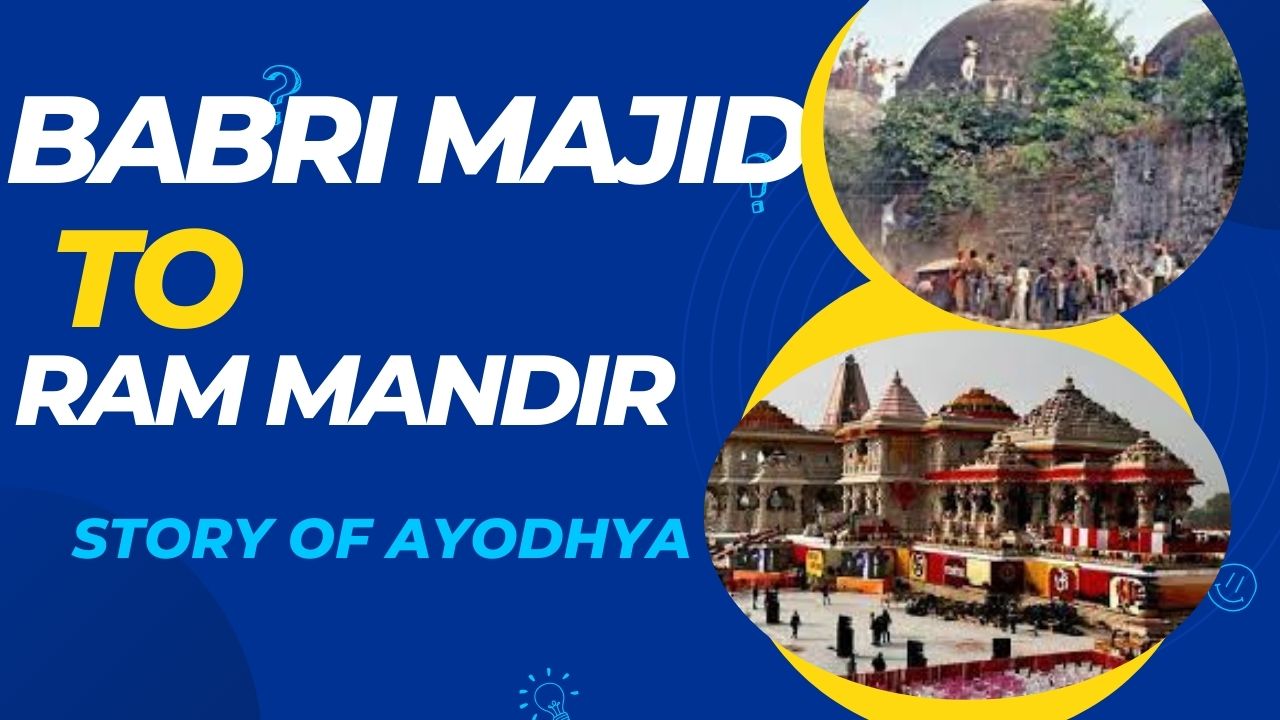On 22nd January 2024, India witnessed the grand consecration ceremony of the Ram temple in Ayodhya. Around the world, Indians celebrate this “historic” day. However, the Ayodhya dispute has been divisive for a long time, with Muslim and Hindu religious organizations involved in multiple legal actions. Let’s have a “historical movement” from Babri Majid to Ram Mandir.
The events of the previous 31 years, which culminated in the consecration ceremony, are a sign of India’s increasing majoritarianism. These represent a significant aspect of the continuous endeavors to marginalize Indian Muslims on the social, economic, and political fronts. Sadly, the higher judiciary in India not only cleared the perpetrators of this heinous crime but also approved the construction of a temple on the site of the destroyed mosque.
This Land’s History
Builtin the sixteenth century, the site was once home to the Babri Masjid. Before the mosque was attacked and destroyed in 1992, the idols of Rama and Sita were installed there in 1949. The Indian Supreme Court ruled in 2019 that Muslims would receive land elsewhere to build a mosque, while Hindus would receive the disputed land for a temple. The Archaeological Survey of India (ASI) report that suggested the existence of a non-Islamic structure beneath the now-demolished Babri Masjid was cited by the court as evidence.
Also Read about youth in Pakistan.
Critics, however, vigorously contested the ASI claims, arguing that they were inconsistent and untrustworthy. However, these were in vain since the ASI report was deemed legitimate by the Supreme Court following extensive deliberations. In a landmark decision, the Supreme Court found that the mosque’s underlying structure was not Islamic and that there was ample evidence that Hindus believed the disputed site to be the birthplace of Rama or Janmabhoomi.
Babur, the first Mughal emperor, is thought to have attacked and destroyed the temple in 1528 during one of his many raids on temples throughout northern India. Later that year, on Babur’s orders, Mir Baqi, the Mughal Empire’s commander, built the Babri Masjid mosque on the site of Rama’s birthplace, the Ram Janmabhoomi.
Joseph Tiefenthaler, a Jesuit missionary, wrote the Latin book Descriptio Indiae in 1767, which contains the earliest known mention of the mosque. He claimed that the mosque was built by demolishing the Bedi, which is home to Rama’s birthplace, and the Ramkot temple, which is thought to be the fortress of Rama in Ayodhya.
In 1853, the first recorded case of religious violence was made. The British government forbade Hindus from performing pujas (rituals) at the disputed site in December 1858. A stage was built so that ceremonies could be held outside the mosque.
The Story of the Babri Mosque Incident
A new movement to restore the site for Hindus and build a temple honoring the infant Rama (Ram Lalla) was started in the 1980s by the Vishwa Hindu Parishad (VHP), a branch of the Hindu nationalist Sangh Parivar family.
The VHP started gathering money and bricks with the words “Jai Shri Ram” inscribed on them. Subsequently, the VHP received approval from the government led by Prime Minister Rajiv Gandhi for Shilanyas or the ceremony to lay the foundation stone. This approval was formally communicated to Ashok Singhal, the leader of the VHP, by Buta Singh, the Home Minister at the time. The governments of Uttar Pradesh and India had initially decided that the sanyas would occur outside the disputed location.
But on November 9, 1989, a group of Sadhus and VHP leaders dug a 200-liter (7-cubic-foot) pit next to the disputed land and laid the foundation stone. There was the construction of the sanctum sanctorum’s singhdwar or main entrance. Next, on the plot of land next to the controversial mosque, the VHP set the foundations for a temple. 150,000 volunteers participated in a rally that the VHP and the Bharatiya Janata Party organized at the location on December 6, 1992. The protest descended into violence as the demonstrators overpowered the police and destroyed the mosque.
An estimated 2,000 people died as a direct result of the demolition of the mosque, which set off riots across the Indian subcontinent and several months of inter-communal violence between the Hindu and Muslim communities in India.
Five terrorists attacked the temporary Ram temple at the location of the demolished Babri Masjid in Ayodhya on July 5, 2005. One civilian perished in the attackers’ grenade attack that broke through the cordoned wall, and the other five were shot and killed in the ensuing clash with the Central Reserve Police Force (CRPF). Three people were lost to the CRPF, two of them had multiple gunshot wounds that left them critically injured.
What effects will the opening of the Ram Mandir have on the Muslims of Ayodhya?
In the predominantly Hindu town of Ayodhya, saffron flags are flying as delighted residents welcome Indian Prime Minister Narendra Modi for the groundbreaking of a brand-new, multimillion-dollar temple.
However, 65-year-old Maulana Badshah Khan says he’ll be staying at home, like many of the 500,000 Muslims in the town.
He worries that there will be another outburst of religious violence similar to what happened more than 30 years ago when Hindu nationalists demolished the Babri Masjid, a mosque from the 16th century, sparking nationwide rioting.
Subscribe TawarePakistan on Youtube
According to Khan, the scars from the destruction of the Babri Mosque will never heal. even if it makes us feel hopeless to express them. The mosque is significant because it represents the Muslims’ position in New India.
Ayodhya has invited over 7,000 individuals to participate in the ceremony in person, including prominent politicians who traveled from all over the country. Additionally, tens of thousands of devout Hindus are pouring into the tiny town to decorate the temple with gifts and flowers.
Amid the growing crowds, Muslims in Ayodhya are feeling uneasy.
The 39-year-old leader of a local religious organization, Azam Qadri, stated that people who experienced the violence in 1992 are afraid of foreigners coming.
There is trouble every time someone enters from the outside. These days, one cannot afford to lose their identity documents, savings, or priceless possessions. It is not simple to start over in life.
Local Muslims, according to Haji Mahboob, who lost two relatives in the 1992 violence, are afraid that the emboldened crowds will chant derogatory slogans against them.
“They will demand a Hindu Rashtra (nation) or call for Muslims to be expelled from Ayodhya,” he stated.
Mahboob claimed that his community is currently experiencing a sense of hopelessness.
He said that many Muslims thought the controversy might end in 2019 after the Supreme Court permitted Hindus to build the temple on the disputed site. However, emboldened Hindus started launching campaigns to demolish even more mosques across the nation.
“What can we do, the Hindus cannot see us, they cannot stand us?” He stated.
Enduring differences
According to Hindu nationalist groups, the temple’s opening represents the birth of a new Hindu nation.
“The opening of the Ram Temple demonstrates to the world that our Hindu customs, practices, and beliefs are still intact, despite attempts to change us by the Mughals and the English. Hindu civilization will reemerge in New India, according to Vinod Bansal, spokesman for the right-wing Vishwa Hindu Parishad party.
The local leader of the BJP’s parent party, the Rashtriya Swayamsevak Sangh, Mahant Jairam Das, stated that he does not think the mosque in Ayodhya should not be built, calling calls for its construction a “call for war.”
“Go to a country where Muslims predominate, like Saudi Arabia or Pakistan. “Why construct a mosque of this kind in India?” he asked.
The sectarian fault lines are evident to Hassan Ali, who was nine years old when he spent two nights in a local police station while attempting to flee the violence in 1992.
There were numerous accounts of local Muslims and Hindus lending a hand to one another in 1992. But people are currently being fed a lot more poison, he claimed. Therefore, one can no longer tell. It’s impossible to know what people are thinking.
Hindu Nationalism’s Ascent
As he campaigned to reform the economy and usher in a new era of development, Modi also vigorously promoted the Hindutva agenda, which holds that India should become a land belonging to Hindus. Modi came to power in 2014.
Numerous states have implemented laws that opponents claim are motivated by Hindutva and discriminatory against Muslims. These laws include those that prohibit the killing and transportation of cows, an animal held in high regard by Hindus, and that make it harder for interfaith couples to get married.
In addition, Modi hopes that erecting the Ram Temple on the site of the destroyed mosque will strengthen his chances of winning an unusual third election this year. This was one of his main campaign promises to the electorate.
The decision by Modi to lead Monday’s celebrations, according to Nilanjan Mukhopadhyay, author of “The Demolition and the Verdict,” a book about the 1992 demolition of a mosque, is evidence of Hindu hegemony in India.
He claimed that Modi’s attendance at the event demonstrated how the distinction between the state and religion is becoming more hazy.
Muslim sentiment, according to Mukhopadhyay, is not one of joy. He’s heard that Muslims counsel one another against taking trains, driving alone, and dressing in ways that would be easily recognized as Muslim.
“Among the Muslims of India, there will be great fear and a great deal of sadness,” he declared.
BJP spokesman Nalin Kohli said that the opening of the Ram Mandir is a “cause for celebration” and that Muslims are not being marginalized in India.
“There is not a single scheme, program, or anything that discriminates between Indian citizens based on religion, caste, or region when it comes to Prime Minister Modi’s government’s work, initiatives, and developmental agenda,” he declared.


Comments are closed, but trackbacks and pingbacks are open.